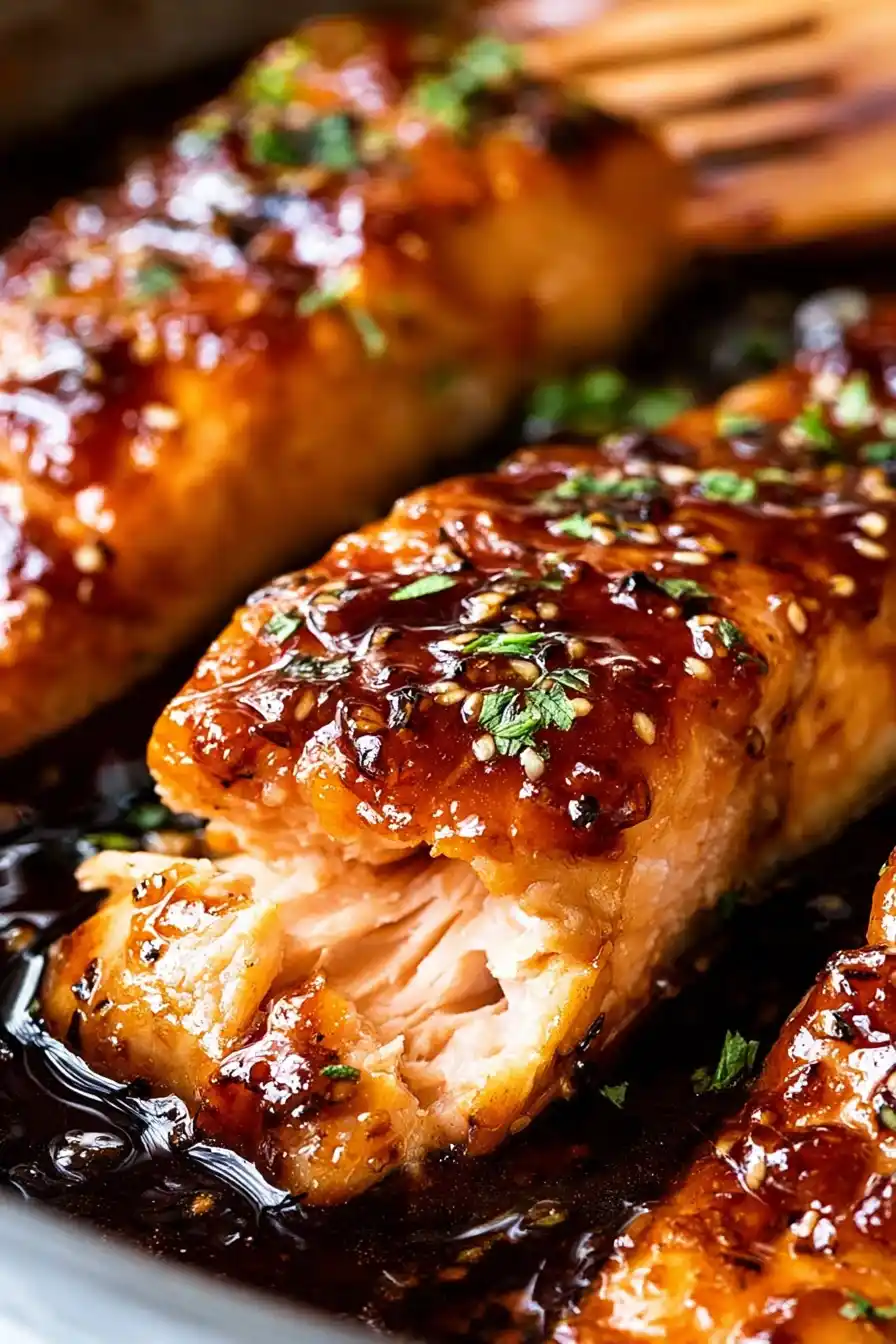Cooking Honey Garlic Glazed Salmon is one of those kitchen wins that never fails to impress. The moment honey meets garlic in a hot pan, the smell fills the room and everyone comes running. This recipe takes less than 20 minutes from start to finish and uses ingredients you probably already have at home.
I first made it on a busy weeknight when I was short on time and patience. My goal was simple: get dinner on the table before the kids started asking for snacks. The result was better than I expected. The glaze turned golden and sticky, clinging to the salmon just enough to give it that restaurant-style shine. My wife took one bite, smiled, and said, “You have to make this again.” That’s when I knew this would be one of our regular dinners.
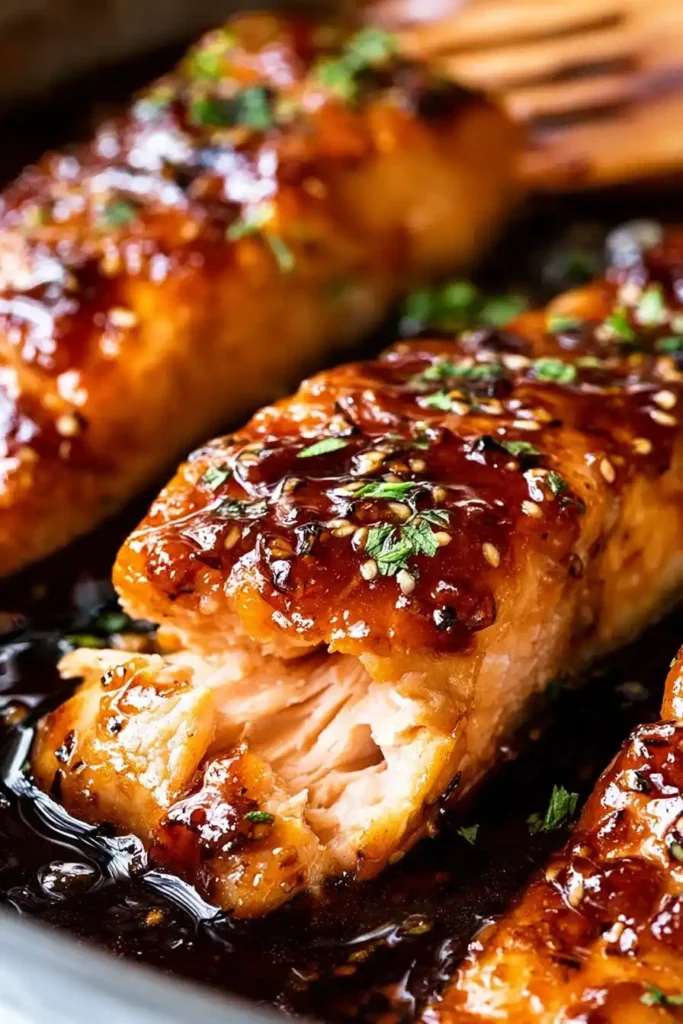
In this article, I’ll show you how to make Honey Garlic Glazed Salmon step-by-step. You’ll learn why the flavor balance works so well, what ingredients make the glaze thick and glossy, and how to fix it if things go wrong. Whether you’re cooking on the stove, in the oven, or in an air fryer, this recipe is fast, flexible, and full of flavor.
Table of Contents
Why This Honey Garlic Glazed Salmon Always Works
The magic behind Honey Garlic Glazed Salmon comes from balance. Sweet honey, bold garlic, savory soy sauce, and a hint of lemon work together to make every bite flavorful but never overwhelming. When the glaze thickens, it coats the salmon beautifully, creating a shiny finish that locks in flavor and moisture.
Here’s what makes this recipe stand out:
- It’s ready in under 20 minutes, start to finish.
- You only need simple pantry ingredients.
- It can be cooked on the stove, in the oven, or in an air fryer.
- The glaze doubles as a sauce for rice, noodles, or vegetables.
Each ingredient has a role.
- Honey brings sweetness and helps the glaze caramelize.
- Garlic adds depth and aroma.
- Soy sauce gives salty umami richness.
- Lemon juice or vinegar adds the brightness that keeps it balanced.
The trick to perfect honey garlic glaze is heat control. Too high and the honey burns. Too low and the sauce stays runny. The best moment to stop cooking is when you see small bubbles forming and the glaze turning slightly darker. That’s when it’s thick enough to coat the fish perfectly.
If you’ve tried my Miso Butter Salmon, this recipe feels like the next step up in flavor. It has that same warmth and comfort but with a sticky sweetness that makes every bite stand out. Even if you’re new to cooking fish, this recipe is simple enough to succeed on the first try.
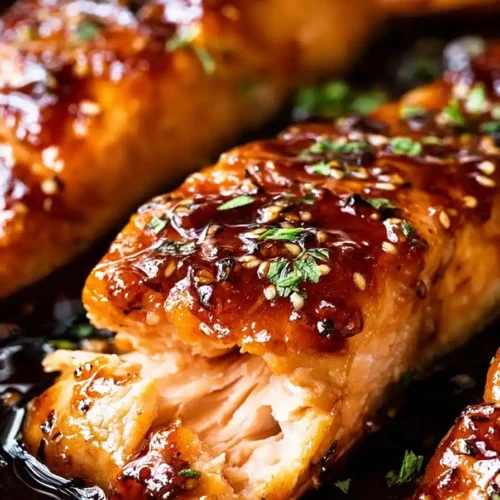
Honey Garlic Glazed Salmon
Equipment
- skillet
- broiler or oven
- measuring spoons
- basting brush or spoon
- paper towels
Ingredients
- 2 salmon fillets
- 2 tbsp honey
- 3 cloves garlic, minced
- 2 tbsp soy sauce
- 1 tbsp lemon juice or apple cider vinegar
- 1 tbsp butter
- 1 tbsp olive oil
- 1 tsp sriracha (optional)
- 1/2 tsp paprika
- to taste salt and pepper
Instructions
- Pat salmon fillets dry with a paper towel. Season both sides with salt, pepper, and paprika for flavor and even browning.
- In a skillet over medium heat, melt butter and olive oil. Add minced garlic, honey, soy sauce, lemon juice, and sriracha. Simmer until slightly thickened, about 2–3 minutes.
- Add salmon to skillet skin-side down. Spoon glaze over top and sear for 3–4 minutes. Transfer to broiler and cook 5–6 minutes, basting once or twice.
- Alternate methods: Bake at 400°F for 12–14 min, grill 3 min per side, or air fry at 390°F for 8–9 min, glazing halfway.
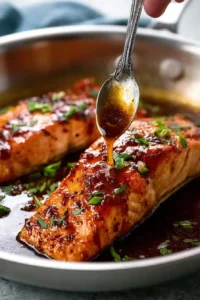
- Serve hot with glaze spooned over top. Pairs well with rice, roasted vegetables, or noodles.
Notes
- To avoid overcooking, remove salmon at 125°F and let it rest.
- Add a splash of water if glaze thickens too fast.
- Great with rice, roasted veggies, or garlic noodles.
- Store leftovers up to 3 days and reheat gently.
- Try alternate methods like baking or air frying for flexibility.
Nutritional Summary
- Serving Size: 1 salmon fillet (6 oz)
- Calories: 481 kcal
- Protein: 38 g
- Carbohydrates: 22 g
- Sugar: 20 g
- Fat: 26 g
- Saturated Fat: 8 g
- Unsaturated Fat: 16 g
- Cholesterol: 98 mg
- Sodium: 640 mg
- Potassium: 750 mg
- Calcium: 25 mg
- Iron: 0.8 mg
Ingredients and Smart Substitutions for Perfect Glaze
The beauty of Honey Garlic Glazed Salmon is that you don’t need anything fancy to make it taste incredible. Most of the ingredients are probably already in your kitchen. The key is using fresh garlic, good honey, and just the right amount of acidity to balance everything out.
What You’ll Need to Make the Sauce Shine
- Salmon fillets – fresh or frozen, thawed completely before cooking.
- Honey – gives the glaze its sweetness and sticky texture.
- Garlic – use fresh minced garlic for stronger flavor.
- Soy sauce – adds saltiness and deep umami flavor.
- Lemon juice or apple cider vinegar – balances the sweetness and brightens the taste.
- Butter or olive oil – creates richness and helps the glaze stick.
- Sriracha (optional) – adds a touch of heat.
- Salt, pepper, paprika – for seasoning the salmon before it cooks.
You can adjust the flavors to match your family’s taste. If you like a stronger glaze, simmer it a little longer to let it thicken. For a lighter version, add a splash of water or broth to thin it slightly.
Simple Ingredient Swaps for Every Diet
If you follow a specific diet, here are easy swaps that keep the flavor but fit your needs.
| Ingredient | Smart Substitution |
|---|---|
| Soy Sauce | Tamari or coconut aminos for a gluten-free version |
| Honey | Maple syrup or agave nectar for vegan-friendly sweetness |
| Butter | Olive oil or avocado oil for a dairy-free version |
| Sriracha | Chili flakes or leave it out if you prefer mild flavor |
Diet-Friendly Tips That Keep Flavor Intact
You can easily tweak this recipe for different lifestyles:
- Low sugar: Use half the honey or mix it with a low-calorie sweetener like monk fruit syrup.
- Gluten-free: Replace soy sauce with tamari or coconut aminos.
- Dairy-free: Swap butter for olive oil.
- Keto-friendly: Reduce the honey and add more soy or tamari for savory balance.
If you love healthy seafood recipes, you can also check out my Miso Salmon Recipes for more quick and flavorful ideas.
How to Cook Honey Garlic Glazed Salmon Step-by-Step
Cooking Honey Garlic Glazed Salmon is all about timing and heat. The goal is to sear the salmon until it’s golden, then finish it in the glaze until it’s sticky, glossy, and tender. Whether you use a skillet, oven, or air fryer, the steps are simple once you know what to look for.
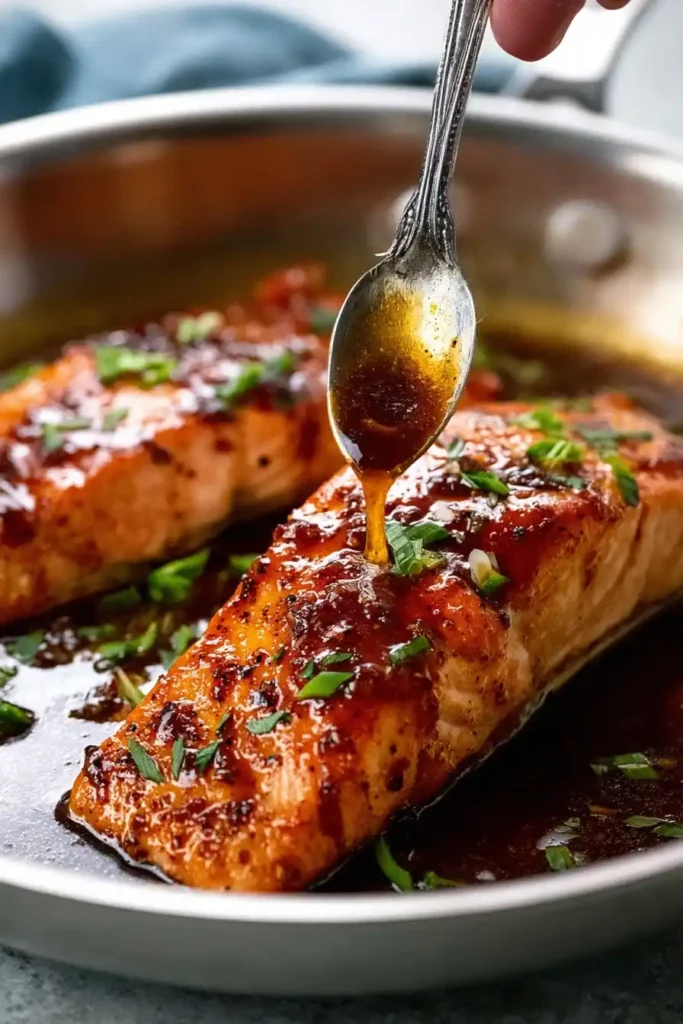
- Prepare the salmon.
Pat the salmon fillets dry with paper towels. Season both sides with salt, pepper, and paprika. A dry surface helps the fish sear evenly and prevents sticking. - Make the glaze.
In a large skillet, melt the butter with olive oil over medium-high heat. Add minced garlic and cook for 30 seconds until fragrant. Stir in honey, soy sauce, lemon juice, and a touch of sriracha. Let the mixture bubble gently until it thickens slightly. - Cook the salmon.
Place the salmon fillets skin-side down in the skillet. Spoon the glaze over the top as it cooks. After about three minutes, the glaze should begin to cling to the surface of the fish. - Finish under the broiler.
Move the skillet to the oven and broil the salmon for five to six minutes. Continue basting it once or twice to help the glaze caramelize. Keep a close eye on it to prevent burning. - Rest and serve.
Once the salmon flakes easily with a fork and the glaze looks thick and shiny, remove it from the oven. Let it rest for two minutes before serving. Sprinkle with fresh parsley or sesame seeds if you like.
This process creates salmon that’s perfectly cooked on the inside and caramelized on the outside. The glaze forms a thin layer of sweetness that balances the natural flavor of the fish.
Alternate Cooking Methods for Honey Garlic Glazed Salmon
If you prefer not to use the stove and broiler, try one of these easy alternatives.
- Baked Honey Garlic Salmon: Preheat the oven to 400°F. Place seasoned salmon on a lined baking sheet. Pour the glaze over the top and bake for 12 to 14 minutes until the fish is cooked through.
- Grilled Salmon: Brush the salmon with glaze and grill over medium heat for about three minutes per side. Reapply glaze just before removing it from the grill.
- Air Fryer Salmon: Set your air fryer to 390°F. Cook for eight to nine minutes, brushing with glaze halfway through. The result is crisp on the outside and juicy inside.
Each method gives a slightly different finish. The skillet and broiler method delivers a thick, sticky glaze, while the air fryer version adds a crisp edge. Baking works best when you want to cook for a group with less cleanup.
Quick Tips for Success
- Always preheat your skillet or oven for consistent results.
- Keep the heat at medium once the glaze begins to bubble.
- Use a spoon or brush to coat the salmon evenly.
- If the glaze thickens too quickly, add a splash of water or lemon juice.
- Stop cooking when the internal temperature reaches 125°F for medium doneness.
Cooking honey garlic glazed salmon gets easier each time you make it. Once you understand how the glaze behaves, it’s simple to control the texture and color for that perfect golden finish every time.
Troubleshooting, Serving, and Storage
Even the best cooks run into small hiccups when making Honey Garlic Glazed Salmon. Maybe the glaze feels too watery or turns darker than you expected. Don’t worry. With a few easy adjustments, you can fix any issue and end up with a glossy, flavorful glaze every time.
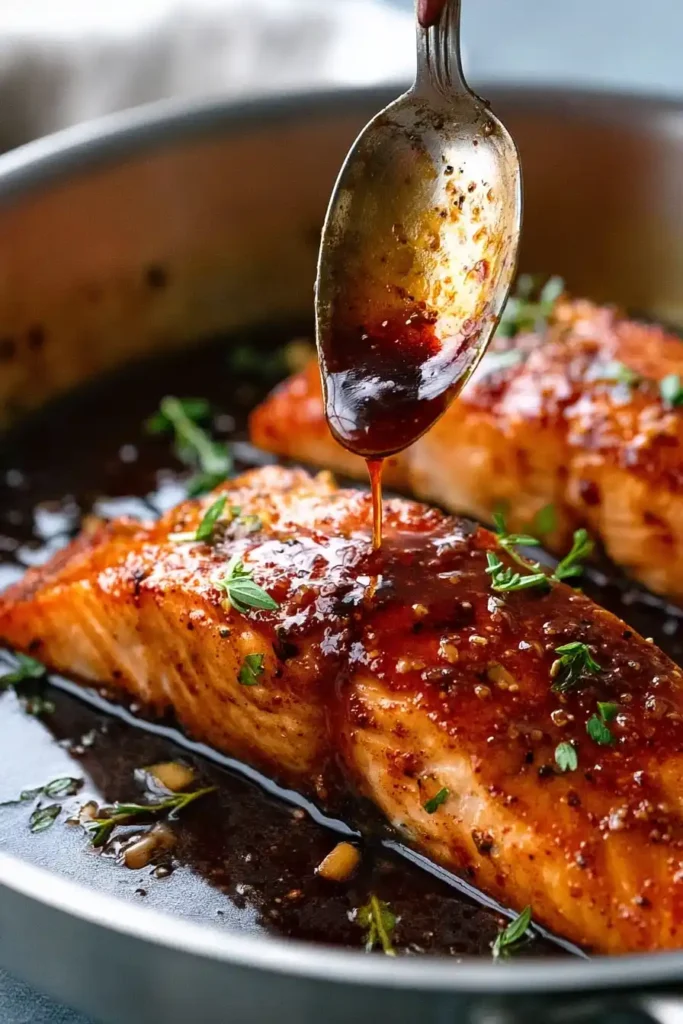
Troubleshooting Common Problems
1. The glaze is too thin.
If your sauce looks watery, simmer it for an extra minute or two. Stir it often so the honey thickens without burning. Reducing the water by half next time will also help create a stickier finish.
2. The glaze burned before the salmon finished cooking.
That happens when the pan gets too hot. Lower the heat and add a teaspoon of water or lemon juice to loosen the glaze. Keep spooning it gently over the salmon as it cooks.
3. The salmon sticks to the pan.
Always preheat the skillet and use enough oil. A hot surface helps seal the salmon quickly, preventing it from tearing. Let it cook for a few minutes before flipping or moving it.
4. The salmon tastes dry.
Dry salmon usually means it stayed under heat a bit too long. The best time to remove it from the pan or oven is when it reaches an internal temperature of about 125°F. It will finish cooking slightly as it rests.
5. The glaze turned cloudy.
If you use salted butter or dark honey, that can happen naturally. It doesn’t affect taste. For a smoother look, try using clear, light honey and unsalted butter.
Delicious Ways to Serve Honey Garlic Salmon
This recipe works beautifully with a variety of sides. The sweet and garlicky glaze pairs best with something light and fresh that balances its richness.
Here are some of my favorite ways to serve Honey Garlic Glazed Salmon:
- Steamed jasmine rice or garlic butter noodles
- Roasted broccoli, asparagus, or green beans
- Crispy potatoes or coconut rice
- A fresh cucumber salad with sesame dressing
- Quinoa with sautéed vegetables
You can also break the salmon into small pieces and serve it over rice bowls or noodles. If you’re hosting, make honey garlic salmon bites as appetizers. They’re easy to eat and always a hit.
For more pairing inspiration, check out my Best Side Dishes for Salmon collection.
How to Store and Reheat Leftovers Without Losing Flavor
If you have leftovers, they store well for up to three days. Place the salmon in an airtight container and refrigerate it once it cools. When you’re ready to eat, reheat it gently on the stovetop over low heat with a small splash of water to refresh the glaze.
Avoid microwaving if possible since it can dry out the fish. The air fryer works well for reheating too. Set it to 350°F for about three minutes to warm the salmon without losing its texture.
You can also make the glaze ahead of time. Store it in a sealed jar in the refrigerator for up to a week. Warm it briefly before using and stir to smooth it out.
Frequently Asked Questions About Honey Garlic Glazed Salmon
How do you make honey garlic sauce for salmon?
Honey garlic sauce is easy to make and takes only a few minutes. Combine honey, soy sauce, minced garlic, and lemon juice in a small pan. Let it simmer over medium heat until it thickens slightly. Once the bubbles start to form and the color turns golden, it’s ready to pour over your salmon. You can make extra sauce and store it in the refrigerator for later use.
Is honey garlic sauce good on salmon?
Yes, it’s one of the best combinations you can try. The sweetness of the honey balances perfectly with the richness of the fish, while the garlic adds depth and aroma. The result is a sticky, flavorful glaze that complements both grilled and baked salmon. It’s also versatile enough to use on shrimp or chicken.
What is the secret to a perfect glaze?
The key is in the balance and heat. The glaze should bubble gently without burning. If it cooks too fast, the honey can caramelize too much and turn bitter. Always stir the sauce while it thickens, and stop when it coats the back of a spoon. Using a mix of honey, soy, garlic, and acid such as lemon juice creates the ideal glossy finish.
How do I avoid burning the honey glaze?
To keep the glaze from burning, lower the heat once it starts bubbling. Avoid using high heat for long periods. If it gets too thick too quickly, add a tablespoon of water or lemon juice and stir. When broiling, move the salmon to the middle rack instead of the top so the glaze caramelizes without turning dark.
What goes with glazed salmon?
Honey Garlic Glazed Salmon tastes great with many sides. Try it with rice, roasted vegetables, or garlic butter noodles. Fresh green salads, steamed broccoli, and mashed potatoes also work beautifully. The glaze has a sweet and savory flavor that pairs well with anything mild and fresh. For more ideas, check out my Easy Side Dishes for Salmon.
Making Honey Garlic Glazed Salmon at home proves that restaurant-quality dinners don’t need to be complicated. In less than 20 minutes, you can turn a few simple ingredients into something that looks and tastes amazing. The sweet honey, roasted garlic, and soy glaze give the salmon a sticky, golden finish that never disappoints.
This recipe fits any night of the week. You can cook it in a skillet, bake it in the oven, or even use an air fryer for quick results. Serve it with rice, noodles, or fresh vegetables, and you’ll have a meal that everyone loves.
In my kitchen, this is one of those recipes that brings everyone to the table. It’s proof that great food doesn’t have to take all day. Once you try it, you’ll keep it in your weekly rotation.

